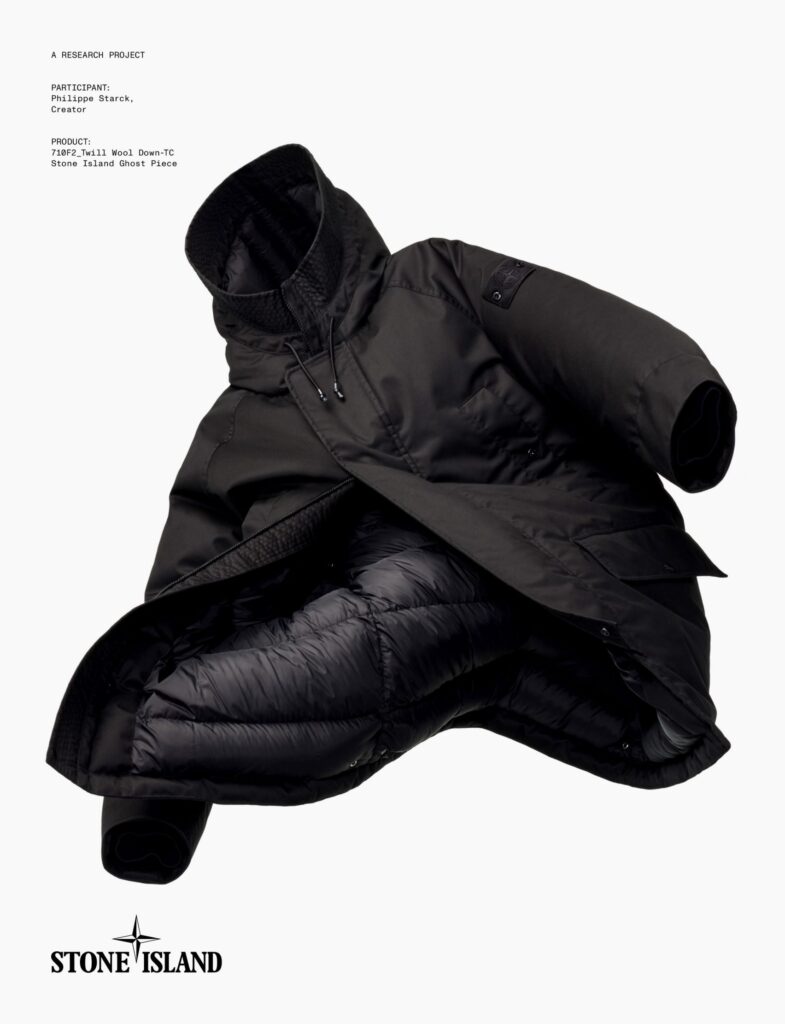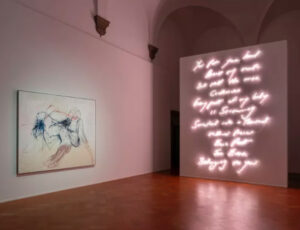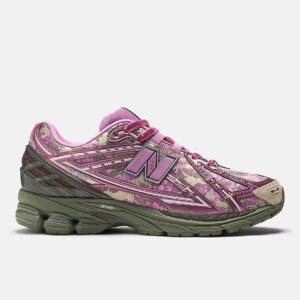In the ever-evolving world of fashion, two seemingly disparate styles—minimalist design and vibrant, eclectic art—have converged in unexpected ways. This intersection is exemplified in two key areas: the Ghost collection, known for its stripped-back, minimalist approach, and Yinka Ilori’s brief yet impactful venture into fashion design through a collaboration with “The North Face”. Both projects highlight how design, whether minimalist or expressive, continues to shape the way we approach clothing, art, and even outdoor gear.
The “Ghost collection”, widely known for its minimalist aesthetic, embraces simplicity and clean lines. Meanwhile, Yinka Ilori, a British-Nigerian designer celebrated for his bold use of color and patterns, brought a new dimension to outdoor wear through his work with The North Face. Ilori’s designs infuse functionality with a vibrant, optimistic energy, drawing on his heritage and personal style. This critical analysis will delve into both design approaches, examining the nuances of minimalism in the Ghost collection and the artistic vibrancy of Ilori’s collaboration, and how these seemingly opposite design philosophies coexist in the broader fashion landscape.
The Minimalist Aesthetic of the Ghost Collection
The Ghost collection represents the epitome of minimalist design. Often, minimalist fashion strips away excess, focusing instead on functionality, clean lines, and neutral tones. The Ghost collection adheres to these principles, creating garments that are unembellished, sleek, and purposeful. Each piece is designed to emphasize the form and structure of the clothing itself, without unnecessary adornments or distracting patterns.
In minimalist design, the focus shifts from ornamentation to construction. Fabrics, cut, and the quality of the materials used take center stage, and this is evident in the Ghost collection. The garments are typically made from high-quality materials that are comfortable, durable, and often sustainable. The idea is that the clothing should speak for itself, without the need for excessive decoration or embellishment. In many ways, this philosophy is a response to the fast-paced, trend-driven nature of contemporary fashion, offering a timeless alternative that prioritizes longevity and simplicity.
The palette of the Ghost collection is another defining feature of its minimalist approach. Minimalist fashion often relies on neutral tones—black, white, beige, and shades of gray—that can be effortlessly mixed and matched. The beauty of this restrained color scheme is its versatility. Pieces from the Ghost collection can be paired together in countless combinations, offering endless wardrobe possibilities without the need for dozens of items. This not only fits into the ethos of simplicity but also aligns with sustainable fashion practices by encouraging consumers to buy fewer, higher-quality garments that last longer.
However, minimalism in fashion is not just about aesthetics or practicality—it also reflects a broader cultural shift towards mindfulness and intentionality. As consumers become more conscious of the impact of their purchases, minimalist fashion offers an alternative to the throwaway culture of fast fashion. The Ghost collection, with its understated elegance and focus on craftsmanship, speaks to this desire for more thoughtful consumption, where each piece is chosen for its quality and purpose rather than its adherence to fleeting trends.
The Functional Design of the Ghost Collection
The functionality of the Ghost collection cannot be overstated. Minimalist fashion, at its core, is about practicality, and the Ghost collection delivers on this front by creating garments that are not only aesthetically pleasing but also functional. The clean lines and simple cuts of the clothing ensure that each piece is versatile and easy to wear, while the high-quality materials guarantee comfort and durability.
One of the key advantages of minimalist design is that it often transcends seasonal trends. The Ghost collection is designed with this in mind, offering pieces that can be worn year after year without looking dated. This timeless appeal is one of the reasons why minimalist fashion continues to be so popular among consumers who value quality and longevity in their clothing.
Moreover, the lack of excessive detailing and ornamentation means that the garments in the Ghost collection are highly adaptable. They can be dressed up or down depending on the occasion, making them suitable for both casual and formal settings. This versatility is a key component of the minimalist ethos, which seeks to streamline and simplify our wardrobes, enabling us to do more with less.
Yinka Ilori: A Designer Bridging Fashion, Art, and Culture
In contrast to the Ghost collection’s restrained approach to design, Yinka Ilori’s work is characterized by its bold use of color, pattern, and storytelling. A British-Nigerian designer known primarily for his work in furniture and interior design, Ilori’s foray into fashion was marked by a collaboration with “The North Face”, an American outdoor brand known for its high-performance gear.
Ilori’s designs are deeply influenced by his Nigerian heritage, and he often incorporates traditional African patterns, bright colors, and playful elements into his work. His collaboration with The North Face allowed him to bring this unique aesthetic to the world of outdoor fashion, creating a collection that was both functional and visually striking.
Ilori’s work is rooted in the belief that design should bring joy and optimism to people’s lives. This philosophy is evident in the vibrant, colorful patterns that define his collaboration with The North Face. The collection features bright, bold designs that stand in stark contrast to the typically muted tones of outdoor gear. By incorporating his signatur color palette, Ilori transformed The North Face’s functional clothing into wearable art, blending fashion, culture, and storytelling in a way that is both visually captivating and deeply meaningful.
The Connection with The North Face
Ilori’s collaboration with “The North Face” marked a significant moment in the outdoor fashion world. Traditionally, outdoor gear prioritizes functionality over aesthetics, focusing on durability, weather resistance, and practicality. While these elements are crucial, they often result in designs that are utilitarian and, at times, visually monotonous. Ilori’s work disrupted this norm, injecting life and color into the world of outdoor fashion.
The pieces in Ilori’s collection for The North Face maintained the brand’s commitment to high-performance materials and functionality. However, Ilori’s vibrant patterns and bold colors brought a sense of playfulness and individuality to the clothing, turning outdoor gear into statement pieces. The collection featured jackets, hats, and bags in bright hues of pink, yellow, blue, and green, all adorned with intricate patterns that reflected Ilori’s signature style.
This collaboration highlighted the increasing crossover between fashion and functionality in the outdoor gear market. In recent years, there has been a growing demand for outdoor clothing that not only performs well in harsh conditions but also looks stylish. Ilori’s designs for The North Face perfectly encapsulated this shift, proving that outdoor gear can be both practical and fashion-forward.
Moreover, the collaboration emphasized the importance of representation and diversity in the fashion industry. Ilori’s Nigerian heritage played a central role in his designs, and by bringing this cultural influence into the collaboration, he helped to broaden the narrative of what outdoor fashion can be. His work with The North Face demonstrated that functional clothing does not have to be devoid of cultural significance or artistic expression. Instead, it can be a canvas for storytelling, creativity, and joy.
Impression
Yinka Ilori’s collaboration with The North Face was significant not only because of its bold aesthetic but also because of the broader conversation it sparked about the role of fashion in outdoor activities. Traditionally, outdoor gear has been designed with a specific, narrow demographic in mind—primarily outdoor enthusiasts who prioritize functionality over style. Ilori’s collection, however, appealed to a wider audience, including those who may not have traditionally engaged with outdoor fashion but were drawn to the collection’s vibrant, artistic flair.
This collaboration also highlighted the growing trend of blending fashion and art. In recent years, there has been a surge in connections between fashion designers and artists, resulting in collections that blur the line between clothing and art. Ilori’s work with The North Face is a prime example of this trend, as his designs brought an artistic sensibility to a functional product. This fusion of fashion and art has become increasingly popular, as consumers seek clothing that not only serves a practical purpose but also expresses their individuality and creativity.
Furthermore, Ilori’s connect with The North Face underscored the importance of diversity and representation in the fashion industry. As a British-Nigerian designer, Ilori brought a unique cultural perspective to the collaboration, infusing the collection with elements of his heritage. This kind of representation is crucial in an industry that has historically been dominated by Western, Eurocentric ideals of beauty and fashion. By incorporating African patterns and vibrant colors into his designs, Ilori helped to broaden the narrative of what fashion can be, making room for more diverse voices and perspectives in the industry.
The Intersection of Minimalism and Expression
While the Ghost collection and Yinka Ilori’s collaboration with The North Face may seem worlds apart, they both reflect the diversity of contemporary fashion and the ways in which design can serve different purposes. The Ghost collection’s minimalist approach emphasizes functionality, versatility, and simplicity, offering a timeless alternative to fast fashion. On the other hand, Ilori’s work with The North Face demonstrates that clothing can be a canvas for artistic expression, bringing joy and cultural significance to even the most utilitarian garments.
What ties these two approaches together is their commitment to quality and thoughtful design. Both the Ghost collection and Ilori’s work are examples of fashion that is designed to last—whether through the timelessness of minimalist design or the cultural significance and storytelling embedded in Ilori’s patterns. In an era of rapid consumerism and disposable fashion, these collections offer a more intentional approach to clothing, one that values craftsmanship, creativity, and sustainability.
Fashion as a Platform for Innovation and Storytelling
The Ghost collection and Yinka Ilori’s collaboration with The North Face exemplify two very different, yet equally powerful, approaches to fashion. The Ghost collection’s minimalist design offers a timeless, versatile alternative to fast fashion, while Ilori’s vibrant, artistic collaboration with The North Face brings joy, color, and cultural significance to outdoor gear.
Both collections highlight the importance of thoughtful, intentional design in an industry that is often driven by fleeting trends. Whether through the simplicity of the Ghost collection or the bold expression of Ilori’s work, these designers remind us that fashion is not just about aesthetics—it is a platform for storytelling, innovation, and cultural expression. As the fashion industry continues to evolve, collaborations like these will play a crucial role in shaping its future, offering new perspectives on what clothing can be and how it can impact our lives.
No comments yet.







